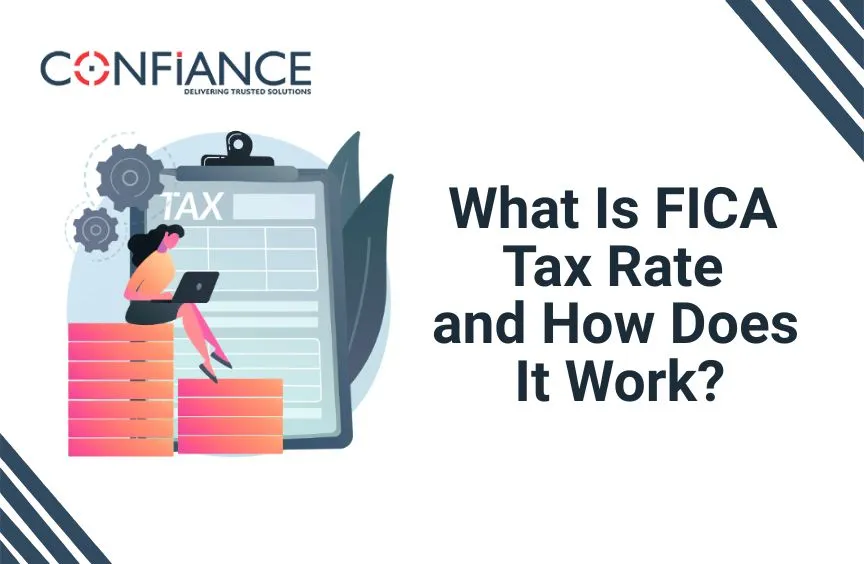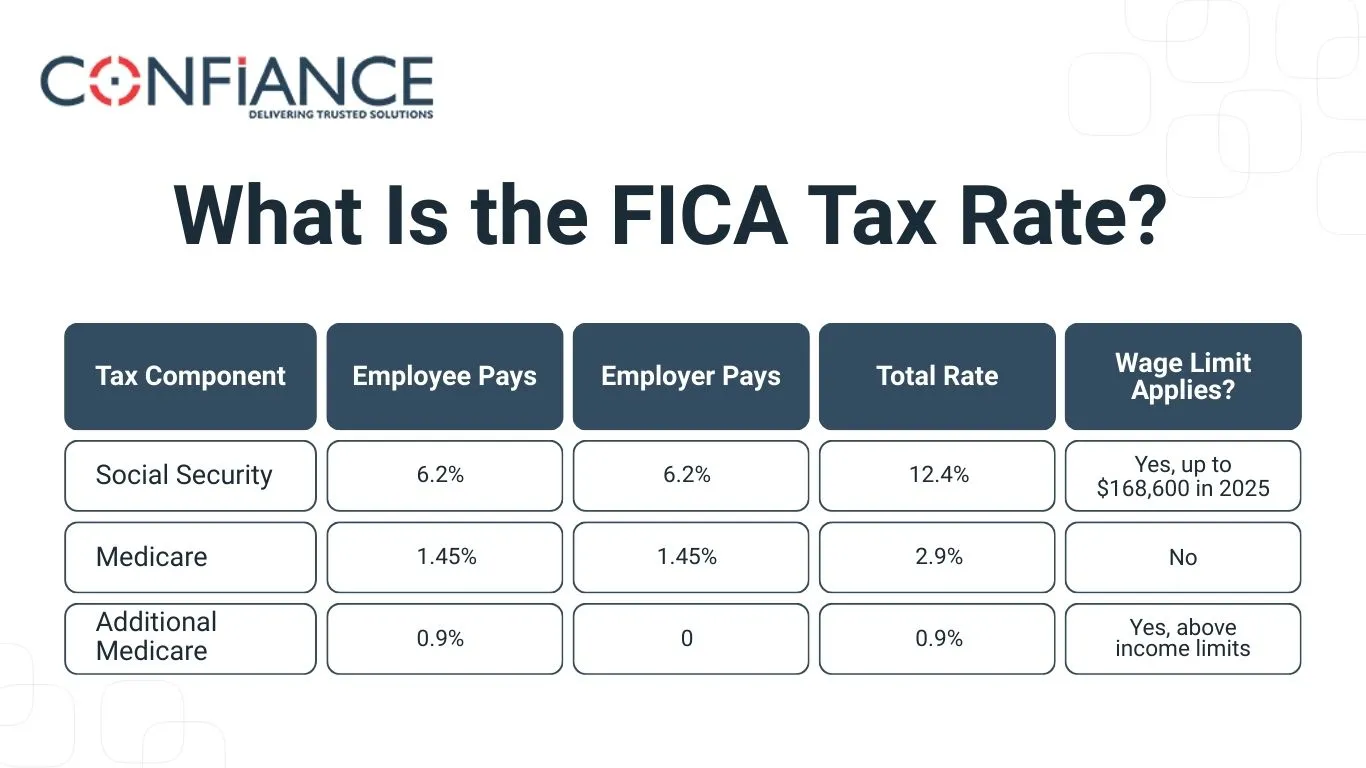
What Is FICA Tax Rate and How Does It Work?
If you live or work in the United States, you’ve probably seen FICA tax taken from your paycheck. Many people see this term but don’t fully know what it means or how it affects their pay. This blog explains the FICA tax rate in clear terms. It also covers how FICA taxation works, who pays it, and why it matters to you.
By reading this, you will get a clear view of how this tax works. You will learn how FICA tax affects your paycheck, connects to your future benefits, and plays a role in your money planning.
What Is FICA Tax?
FICA tax stands for Federal Insurance Contributions Act tax. This law makes sure part of your pay is held back to fund two key government programs: Social Security and Medicare.
Social Security gives money to retired workers. It also helps those who can’t work due to disability. It supports families after a worker’s death. This program acts as a safety net for millions of people.
Medicare helps pay for medical costs for people 65 or older. It also helps some younger people with certain disabilities. Medicare covers hospital stays, doctor visits, and other health care.
When you pay FICA tax, you help fund these programs. The money you pay now helps those using the services today. Later, it will help you when you retire or need health care.
Why Was FICA Tax Created?
Before Social Security and Medicare, many people had no income after retiring or getting disabled. This caused money troubles for many families.
In 1935, the government started Social Security to fix this problem. It aimed to give basic income to retired and disabled workers. In 1939, FICA was passed to create a tax system to pay for Social Security. Medicare was added in 1965 to cover health costs for older and disabled people.
FICA taxation acts like forced savings mixed with insurance. When you work, part of your wages is set aside to help you later. This system makes sure money is there for millions when they need help.
Who Pays FICA Tax?
Almost all workers in the U.S. pay FICA tax. If you work for an employer, they take your share from your paycheck. Your employer also pays the same amount for you. This means both you and your employer share the FICA tax cost.
The main groups who pay FICA tax are:
- Full-time workers
- Part-time workers
- Temporary and seasonal workers who earn wages
This way, everyone who earns pay helps fund Social Security and Medicare.
Who Does Not Pay FICA Tax?
Some people do not pay FICA tax. These include:
- Certain government workers with their own retirement plans
- Students working for their schools under special rules
- Some foreign workers on specific visas
- Members of religious groups who choose to opt out for beliefs
If you fit these groups, you may not see FICA tax taken from your pay.
What Is the FICA Tax Rate?
FICA tax has two parts. One goes to Social Security and the other to Medicare. Both workers and employers pay their share.
Social Security Tax Rate
Workers pay 6.2% of pay for Social Security. Bosses pay the same 6.2%. Together, the full Social Security tax rate is 12.4%. This tax applies only to pay up to $168,600 in 2025. Any pay above this is not taxed for Social Security.

Medicare Tax Rate
Workers pay 1.45% of all pay for Medicare. Bosses also pay 1.45%. Together, the Medicare tax rate is 2.9%. This tax applies to all pay with no limit.
Extra Medicare Tax for High Earners
If you earn over a set sum, you pay an extra 0.9% Medicare tax on pay above that sum. This extra tax applies only to workers, not bosses. The limits are:
- $200,000 for single filers
- $250,000 for married couples filing together
- $125,000 for married couples filing apart
| Tax Component | Employee Pays | Employer Pays | Total Rate | Wage Limit Applies? |
| Social Security | 6.2% | 6.2% | 12.4% | Yes, up to $168,600 in 2025 |
| Medicare | 1.45% | 1.45% | 2.9% | No |
| Additional Medicare | 0.9% | 0 | 0.9% | Yes, above income limits |
How Does FICA Taxation Work?
Every time you get paid, your employer figures your FICA taxation based on wages:
- 6.2% Social Security tax on wages up to the limit
- 1.45% Medicare tax on all wages
- Extra 0.9% Medicare tax if wages are above the limit
Your employer takes these taxes from your paycheck and also pays the same amounts. Both shares go to the government.
At the year’s end, your employer gives you a W-2 form showing total wages and FICA tax withheld.
Example of FICA Tax Calculation
If you earn $75,000 yearly, your FICA tax is:
- Social Security: 6.2% of $75,000 = $4,650
- Medicare: 1.45% of $75,000 = $1,087.50
- Total FICA tax: $5,737.50
Your employer pays the same. Together, $11,475 goes to the government.
If you earn over $168,600, Social Security tax only applies up to $168,600. Medicare tax applies to all wages.
FICA Tax for Self-Employed People
If you work for yourself, you pay the full FICA tax, called self-employment tax:
- 12.4% Social Security tax on net earnings up to the limit
- 2.9% Medicare tax on all net earnings
- Extra 0.9% Medicare tax on net earnings over the limit
Self-employed people report and pay this tax on their tax return. They can deduct half of this tax from their income.
How FICA Tax Affects Your Paycheck
FICA tax lowers your take-home pay. For example, if you earn $1,000, about $76.50 goes to Social Security and Medicare.
This leaves less money now but builds your benefits for later.
Knowing this helps you budget and read your paycheck better.
Why FICA Tax Matters
FICA tax funds two key programs:
- Social Security pays retirees and disabled workers
- Medicare helps cover health costs for older and disabled people
Paying FICA tax earns credits needed to get these benefits. If you don’t pay FICA tax, you might not get these benefits when you need them.
Who Is Exempt From FICA Tax?
Some groups don’t pay FICA tax:
- Some state and local government workers with other retirement plans
- Students working for their schools under certain rules
- Some nonresident aliens on special visas
- Members of religious groups who opt out for faith reasons
Check carefully if you think you may be exempt.
What Employers Do About FICA Tax
Employers must:
- Calculate your FICA tax each pay period
- Withhold your share from your paycheck
- Pay their matching share
- Send both shares to the government
- File payroll tax returns
- Provide a W-2 form showing wages and taxes withheld
Many employers use payroll software for accuracy.
Tips for Managing FICA Tax
If you are self-employed or have many income sources:
- Set aside money for self-employment tax
- Pay quarterly taxes to avoid penalties
- Keep clear records of income and taxes
- Ask a tax expert for help if needed
Knowing what FICA tax is and the current rates helps you understand your pay and benefits. This tax funds Social Security and Medicare, programs that help millions.
Though FICA tax lowers your take-home pay today, it builds a safety net for later. Check your paychecks regularly and plan with FICA tax in mind. Being informed helps you control your money now and secure your future.
If you need help or have questions about FICA tax, talk to a tax expert at Confiance. Staying informed helps you avoid surprises and make better money choices. Contact us now to schedule a meeting with our tax expert.
FAQs
- Can I avoid paying FICA tax?
Almost no, unless you are exempt by law. - Is FICA tax the same as income tax?
No. Income tax funds many programs. FICA tax funds only Social Security and Medicare. - Does FICA taxation apply to bonuses and tips?
Yes, all wages count. - What if I have more than one job?
Each employer takes FICA tax separately. If you pay too much Social Security tax, you can get a refund. - How can I check how much FICA tax I paid?
Visit the Social Security Administration website and check your earnings record.
